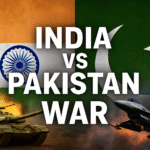
Introduction: A Strategic Puzzle in South Asia
When we talk about South Asian geopolitics, the triad of Pakistan, India, and China commands global attention. The focus keyword, “India Pakistan war,” often resurfaces in international headlines, but lurking behind the scenes is China’s quiet, strategic support for Pakistan. This alliance raises questions: What fuels China’s unwavering backing of Pakistan? How does this shape the region’s power dynamics, especially during instances like an India mock drill or rising tensions across the Line of Control?
Understanding the China-Pakistan alliance requires looking beyond simple diplomatic niceties and diving into shared interests, military collaborations, and economic dependencies. Let’s unpack this complex yet calculated relationship.
Historical Roots of the Alliance
China and Pakistan have maintained cordial relations since the early 1950s, but it was the 1962 Sino-India war that truly solidified their bond. With a common adversary—India—China and Pakistan found a strategic ally in each other.
Key events that shaped the alliance:
- 1963: Pakistan ceded part of Kashmir (Shaksgam Valley) to China, strengthening territorial links.
- 1976: China built the Karakoram Highway, symbolizing not just infrastructure but interdependence.
- 2000s onward: Bilateral trade, military cooperation, and nuclear technology exchanges intensified.
The foundation of this alliance lies in mutual interests—Pakistan offers strategic depth to China, while China provides economic, military, and diplomatic shielding.
Economic Interdependence: The CPEC Factor
One of the crown jewels of this relationship is the China-Pakistan Economic Corridor (CPEC), part of China’s ambitious Belt and Road Initiative.
Key highlights of CPEC:
- $62 billion in infrastructure projects
- Access to Gwadar Port, giving China a direct route to the Arabian Sea
- Development of highways, energy plants, and rail networks in Pakistan
This economic corridor not only helps Pakistan’s struggling economy but also provides China with critical access to global maritime trade routes. In return, Pakistan remains loyal, often backing China in international forums, including on sensitive topics like Taiwan or Xinjiang.
Military and Strategic Collaboration
China has become Pakistan’s largest supplier of military equipment. From fighter jets (like the JF-17) to advanced missile systems, Beijing ensures Pakistan stays militarily competitive with India.
Key military collaborations:
- Joint air exercises
- Naval cooperation in the Arabian Sea
- Satellite and surveillance tech sharing
In contrast, India’s aggressive defense strategy, seen through frequent mock drills and strategic alignments with countries like the US, Australia, and Japan (e.g., the Quad), puts pressure on China. Supporting Pakistan serves as a counterbalance.
Diplomatic Shielding on Global Platforms
On global stages like the United Nations, China often shields Pakistan from scrutiny, especially on issues related to terrorism or Kashmir.
For instance:
- China has blocked India’s attempts to list Jaish-e-Mohammed’s Masood Azhar as a global terrorist multiple times.
- China has consistently supported Pakistan’s stance on Kashmir, viewing it as a bilateral issue.
This diplomatic muscle helps Pakistan manage international pressure, particularly after incidents such as surgical strikes or escalated border skirmishes.
Shared Distrust of India
Both nations share a wary view of India’s regional ambitions. India’s growing economy, modernizing military, and rising global influence are seen as threats by both Beijing and Islamabad.
China’s support for Pakistan during India-Pakistan war episodes or during heightened military tensions is a strategic move to keep India’s power in check. Conversely, Pakistan sees China as a trusted ally who counters India’s dominance.
India’s Mock Drills: A Provocation or Preparation?
India frequently conducts military mock drills to simulate potential war scenarios, often in regions close to Pakistan and China. These exercises—though routine from India’s standpoint—are perceived by its neighbors as muscle-flexing.
China’s backing of Pakistan in response includes:
- Issuing statements of concern
- Conducting parallel drills with Pakistan
- Reinforcing security presence in border regions
This tit-for-tat military posturing only strengthens the triangle of tension in South Asia.
A Table Overview: China-Pakistan vs. India
| Factor | China-Pakistan Alliance | India’s Position |
|---|---|---|
| Military Cooperation | High: Joint exercises, tech sharing | Strong: Indigenous defense development |
| Economic Link | Deep: CPEC, Belt & Road | Expanding: U.S., EU, ASEAN partners |
| Diplomatic Support | Consistent backing on global platforms | Independent and vocal in diplomacy |
| Common Strategic Goals | Counterbalance India | Regional dominance, counter-China |
Expert Opinions
According to Carnegie Endowment for International Peace, the China-Pakistan partnership is “not just strategic but symbolic—an ‘all-weather friendship’ reinforced by tangible cooperation.”
In a Brookings report, analysts suggest that China’s investments in Pakistan serve both strategic and economic goals, allowing China a military and maritime foothold near the Indian Ocean.
Conclusion: More Than Just a Friendship
The alliance between China and Pakistan is complex, calculated, and continually evolving. It’s not simply about friendship—it’s a multi-dimensional partnership that serves both countries’ strategic interests in countering India’s growing power.
Whether it’s responding to an India mock drill, supporting Pakistan during periods of high military tension, or shielding it on global stages, China’s role in the South Asian puzzle is undeniable.
Understanding this dynamic isn’t just for scholars or diplomats—it’s crucial for anyone interested in how global power structures shift in real time. As India continues to rise, the China-Pakistan bond will likely deepen, making South Asia a focal point in future geopolitical narratives.
